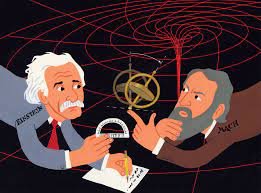Mass is both a property of a physical body and a measure of its resistance to acceleration (a change in its state of motion) when a net force is applied.
The Higgs boson discovered at the CERN particle physics laboratory near Geneva, Switzerland, in 2012, is what, according to the Standard Model of particle physics gives all other fundamental particles mass. However, despite the work of thousands of researchers around the world, nobody has been able to figure out exactly how it does that or why some particles are more massive than others.
However, there is another way to understand mass and its resistance to acceleration based solely on the field concepts of Einstein’s theories.
For example, Einstein defined the physicality of mass in terms of the energy density associated with a displacement in space-time which he quantified by the equation E=mc^2. This means he also defined the reason some particles are heavier than others is because they have a greater displacement and therefore a greater energy content than other masses. Pitting it another way the equation E=mc^2 not only defines physicality of mass but also quantifies why some particles are heavier that others in terms of in terms of the field properties of space-time.
However, his equations and the observations of particles in particle accelerators tell us the relativistic mass of a body increases over its finite rest mass as it is accelerated with respect to an observer and that energy must be added to it to do so.
He also tells us the rate at which energy can added to a mass is limited by the speed of light. This means according to Relativity, the reason why mass resists acceleration is because the speed at which energy can be added to it is limited. Putting it another way according to it, the reason for its resistance to acceleration MAY not be related to the field properties of a Higgs boson but to the field properties of space-time that limits the rate at which energy can be added to it.
This conclusion is supported by the fact that because Einstein’s relativistic equations tell us that mass or its energy content increases as it approaches the velocity of light it will take more energy to make an incremental change in it. Therefore, because it limits the speed at which energy can be added to it, it will resist acceleration more than one that is at rest with respect to an observer.
In other words, one does not need the Higgs boson to explain a particles mass and why it resists a change in motion because one can use the OBSERVABLE properties of our environment and of Einstein’s theories to do so.
Hey! I realize this is sort of off-topic but I needed to ask.
Does building a well-established blog such as yours require a
large amount of work? I’m completely new to operating a blog but I do write in my diary daily.
I’d like to start a blog so I can share my own experience and thoughts online.
Please let me know if you have any kind of recommendations or tips for brand new aspiring blog owners.
Thankyou!